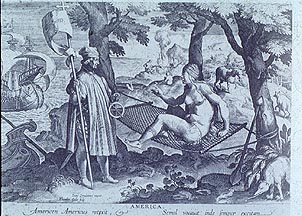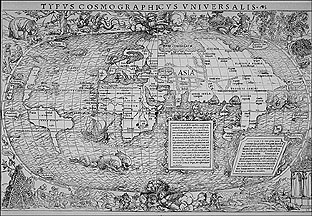

The above engraving entitled America, ca. 1580. Engraving by Theodor Galle after a drawing by Jan van der Straet (ca. 1575) re-presents Amerigo Vespucci "discovering" America. This image is a powerful visualization of the ideology of colonialism. It can also be seen to echo ideas of primitivism in Western Culture.
Consider the similarities of the image above to the Creation of Adam of the Sistine Ceiling by Michelangelo.
The following excerpts explore the implications of this image:
Louis Montrose, "The Work of Gender in the Discourse of Discovery," in New World Encounters, ed. Stephen Greenblatt, University of California, 1993, pp. 179-180: By the 1570's, allegorical personifications of America as a female nude with feathered headdress had begun to appear in engravings and paintings, on maps and title pages, throughout Western Europe. Perhaps the most resonant of such images if Jan van der Straet's drawing of Vespucci's discovery of America, widely disseminated in print in the late sixteenth century by means of Theodor Galle's engraving. Here a naked woman, crowned with feathers, upraises herself from her hammock to meet the gaze of the armored and robed man who has just come ashore; she extends her right arm toward him, apparently/ p. 180 gesture of wonder --or, perhaps, of apprehension. Standing with his feet firmly planted upon the ground, Vespucci observes the personified and feminized space that will bear his name. This recumbent figure, now discovered and roused from her torpor, is about to be hailed, claimed, and possessed as America. As the motto included in Galle's engraving puts it, "Americen Americus retexit, & Semel vocavit inde semper excitam" --"Americus rediscovers America; he called her once and thenceforth she was always awake." This theme is discreetly amplified by the presence of a sloth, which regards the scene of awakening from its own shaded spot upon the tree behind America. Vespucci carries with him the various empowering ideological and technological instruments of civilization, exploration, and conquest: a cruciform staff with a banner bearing the Southern Cross, a navigational astrolabe, and a sword-- the mutually reinforcing emblems of belief, empirical knowledge, and violence. At the left, behind Vespucci, the prows of the ships that facilitate the expansion of European hegemony enter the pictorial space of the New World; on the right, behind America, representatives of the indigenous fauna are displayed as if emerging from an American interior at once natural and strange.
Close to the picture's vanishing point --in the distance, yet
at the center-- a group of naked savages, potential subjects of
the civilizing process, are preparing a cannibal feast. A severed
human haunch is being cooked over the fire; another, already spitted,
awaits its turn. America's body pose is partially mirrored by
both the apparently female figure who turns the spit and the clearly
female figure who cradles an infant as she awaits the feast. Most
strikingly, the form of the severed human leg and haunch turning
upon the spit precisely inverts and miniaturizes America's own.
In terms of the pictorial space, this scene of cannibalism is
perspectivally distanced, pushed into the background; in terms
of the pictorial surface, however, it is placed at the center
of the visual field, between the mutual gazes of Americus and
America, and directly above the latter's outstretched arm....
/p. 181 The elements of savagery, deceit, and cannibalism central
to the emergent European discourse on the inhabitants of the New
World are already in place in this very early example. Of particular
significance here is the blending of thse basic ingredients of
protocolonialist ideology with a crude and anxious misogynistic
fantasy, a powerful cunjunction of the savage and the feminine.
Michel de Certeau, The Writing of History, pp. xxv-xxvi: Amerigo Vespucci the voyager arrives from the sea. A crusader standing erect, his body in armor, he bears the European weapons of meaning [a cruciform staff with a banner bearing the Southern Cross, a navigational astrolabe, and a sword --each of these referring to discourses of mastery --religious truth, scientific truth, and military power]. Behind him are the vessels that will bring back to the European West the spoils of a paradise. Before him is the Indian "America," a nude woman reclining in her hammock, an unnamed presence of difference, a body which awakens within a space of exotic fauna and flora. An inaugural scene: after a moment of stupor, on this threshold dotted with colonnades of trees, the conqueror will write the body of the other and trace there his own history. From her he will make a historied body --a blazon-- of his labors and phantasms. She will be "Latin" America.
This erotic and warlike scene has an almost mythic value. It represents
the beginning of a new function of writing in the West. Jan Van der
Straet's staging
of the disembarkment surely depicts Vespucci's surprise as he faces this
world, the first to grasp clearly that she is a nouva terra not
yet existing on maps --an unknown body destined to bear the name, Amerigo,
of its inventor.
But what is really initiated here is a colonization of the body by the discourse
of power, This is writing that conquers . It will use the New
World as if it were a blank, "savage" page on which Western desire will be
written. It will transform the space of the other /p.xxvi into a field of expansion
for a system of production. For the moment of a rupture between a subject and
an object of the operation, between a will to write and a written
body (or a body to be written), this writing fabricates Western history....
Compare the figure of Amerigo Vespucci to the tradition of Roman imperial images that include works like the Colussus of Barletta from the early fifth century:
Consider also the cuirass from the Augustus of Primaporta:
On the breastplate the Barbarian (the Parthian) is shown submitting to Roman authority. This surrender is put into universal terms with the heavens above and the earth below. The personification of earth as a female figure, characteristic of Ancient civlization, reinforces the patriarchal nature of Roman society. Earth is matter needing to be given form or nature transformed into culture. |
John Flynn wrote in 1944: "The enemy aggressor is always pursuing a course of larceny, murder, rapine and barbarism. We are always moving forward with high mission, a destiny imposed by the Deity to regenerate our victims while incidentally capturing their markets, to civilise savages and senile and paranoid peoples while blundering accidentally into their oil wells."
The following is an excerpt
from an editorial written by Dan Plesch entitled "A con trick for western
liberals: How the US and Britain can back democracy and disarmament now"
that appeared in The Guardian, 3/7/03:
The idea that we can invade Iraq to bring democracy and freedom is a confidence
trick designed to draw western liberals into providing legitimacy for old-fashioned
conquest. We have been here before. In the late 19th century, Christian missionaries
provided countless factual accounts of the barbarities of the heathen in Africa
which were used to justify intervention and, in the end, the conquest, exploitation
and partition of the continent. Iraq is a state created by the British empire
after 1918 and was under London's influence until 1958. We have yet to come
to terms with the cruelties of our own empire. But once again, local brutalities
are being used to justify our own attacks....
People in Iraq will doubtless cheer at being freed from Saddam's gang - I would. But I would also have no illusion that the motives of the invaders are conquest of natural resources wrapped up in old fashioned racist stereotypes. Don't be conned into picking up the white man's burden.
Joseph Schumpeter in a 1919 essay entitled "The Sociology of Imperialisms," wrote, "There was no corner of the world where some interest was not alleged to be in danger or under actual attack. If the interests were not Roman, they were of Rome's allies, and if Rome had no allies, then allies would be invented. When it was utterly impossible to contrive such an interest-why, then it was the national honor that was insulted. The fight was always invested with an aura of legality. Rome was always being attacked by evil-minded neighbors. The whole world was pervaded by a host of enemies, and it was manifestly Rome's duty to guard against their indubitably aggressive designs." Just substitute United States for Rome today and see if there is some resonance and echo.
Compare this statement above to the rhetoric employed by George W. Bush to justify his policies in Afghanistan and Iraq.


Consider how this discourse of discovery is still being used in our culture as exemplified by the following ad for the Liz Claibourne fragrance Bora Bora:
